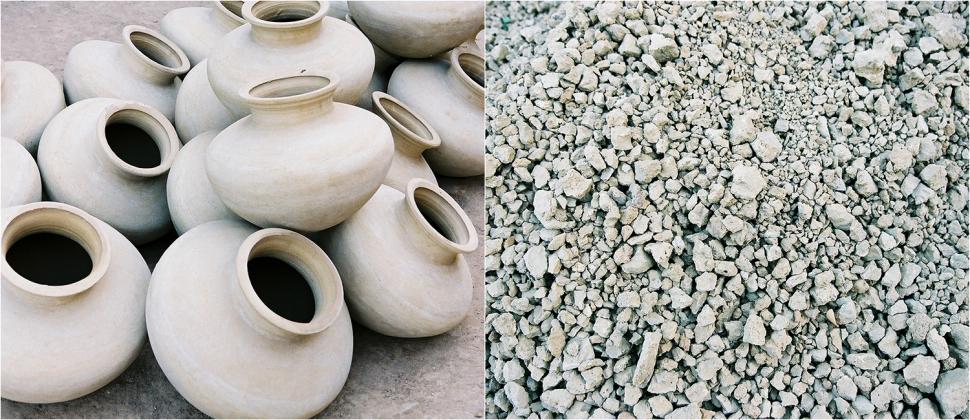Kachchh & Clay
Traditionally, potters shared a very close relationship with different communities in the villages as the communities were totally dependent on the potters to supply the earthenware to not only run the kitchens but also to observe various rituals associated with festivals and related occasions of birth, marriage and death.
The potters work very closely with their surrounding environment. Natural resources such as clay, water, leaves of plant called ‘Jaru’ (local name), thorns and tender stems of ‘Prosopis Julifera’, ‘white clay’ and black stone is required by the potters for activities related to the craft.

Kachchh and Clay
Clay is used to make pottery items, water is used to prepare the dough of the clay, leaves of ‘jaru’, thorns and stems of ‘Prosopis Julifera’ are used to cover the kiln during firing the vessles, ‘white clay’ and ‘black stone’ are used for decorating the vessels. All these used to be available to the potters very easily and free of cost.
Modern Wheels
The prime concern today is the high dropout rate of potters from their craft. In villages where there used to be 30 potters, today there are just a handful of 3 or 4. The major factor that leads to this is the absence of appreciation of their role in society today. Modern life today can do without the potter or his products.

Pottery Process
Even their relationship with natural resources is badly affected post the industrialization in Kachchh. Today the potters face a lot of difficulty in getting clay and white mud because industries and houses are being built on lands fertile for clay and white mud. Potters are forced to explore areas and cover greater distances for availing the same. At places like Rapar and Bhachau, water scarcity had become so crucial that the potters have to buy water not only for the household but also for their craft related activities.
The availability of the thorns and tender stems of ‘Prosophis Julifera’ has also become difficult. These are required to cover the kiln during the firing of the pottery items. The charcoal makers destroy large portions of Prosophis Julifera’ and they have cleared all the cover standing nearing the villages. As a result potters have to travel a lot to collect the thorns and stems of this plant. Generally women of the family go for the collection of thorns and stems and carry them home on their heads. A woman spends considerable time on this as she has to cover long distances by walking.
The complete replacement of potter’s products with metal and plastic in day-to-day use, social stigma of working with clay and access to good quality clay for the potter, the complete apathy of modern living to provide space in the system for this large section of society is the concern of the day.
Future Ceramics
Khamir initiated pottery craft programs by working with artisans in Lodai, Khavda and Gundiyali clusters. Currently the kiln and the pottery studio on the Khamir campus, is available to potters.
Khamir has fostered many collaborations with potters. A workshop with 10 potters was held by Rakhi Kane of Auroville to develop clay tiles. Through IICD, Jaipur, pottery products like lamp shades and grills were developed. Khamir brings artists who have strong technical backgrounds and are well established in the craft to work with the potters of Kachchh directly. Today many pottery artisans of Kachchh are coming forward to learn and experiment with various clays, firing and glazing techniques, designs and product range. Since 2013, Khamir and Ceramic Center, Baroda, joined hands to work together on the various issues of the pottery clusters in Kachchh.
Architectural products were showcased and praised at various exhibitions, including an exhibition “Stroke on-Trent”, organized by the British Ceramics Biennial in London in collaboration with the company A Fine Line.